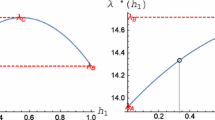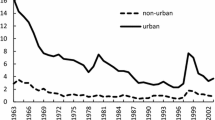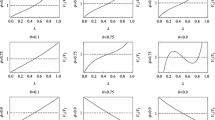Abstract
This study revisits the seminal findings by Helpman in 1998 in a more comprehensive setup with Melitz-type firm heterogeneity. Our model features how a change in firm heterogeneity affects agglomeration in an urban-space economy. We contribute to the literature by analytically giving explicit solutions for the threshold values of the housing preference and transport costs that are crucial in determining the equilibrium. We also obtain new findings in the case of asymmetric housing stocks. Our results provide alternative explanations to stylized facts such as “ghost cities” in countries undertaking high-speed urbanization and real estate development.


Similar content being viewed by others
Notes
See Ottaviano (2011) for a review of this stream of literature.
Note that for symmetric regions, we have \(w_1=w_2\) and \(\varphi _1^*=\varphi _2^*\) such that \(\varphi _{2x}^*>\varphi _1^*\) implies \(\varphi _{2x}^*>\varphi _2^*\) whereas \(\varphi _{1x}^*>\varphi _2^*\) implies \(\varphi _{1x}^*>\varphi _1^*\). For asymmetric regions, ensuring that only domestically active firms export imposes a limit on relative wages. The limit condition is discussed in the online appendix.
Assuming a Pareto distribution implies that average productivity results as a constant markup over the respective cutoff levels, that is \(\tilde{\varphi }_1/\varphi _1^*=\tilde{\varphi }_{1x}/\varphi _{1x}^* =[k/(k-\sigma +1)]^{1/(\sigma -1)}\), which helps to simplify the mathematical expressions.
We examine the case of asymmetric housing stocks in Sect. 4.4.
Readers who are interested in stability analysis of spatial models with dynamics could reference, for example, Neto and Claeyssen (2015).
Note that, if \(\sigma\) is high, consumers view different varieties as closer substitutes and care little about the available variety choice, which enlarges the range of stable symmetric equilibrium. As shown in “Appendix 2”, a higher \(\sigma\) decreases the range of stable full agglomeration.
The scenario of \(\lambda =0\) can be derived analogously.
In our model with firm heterogeneity, trade liberalization also works through an exporter selection effect. Lower transport costs allow less productive firms to earn positive profits from foreign markets, which implies a higher propensity to export and raises the share of available varieties in each market. At the same time, intensified competition from high-productive firms drives the least productive firms out of the market and raises the output and market share of each incumbent. As also mentioned by Ehrlich and Seidel (2013, p. 543), “Firm heterogeneity works in a very similar way as the selection effects that come along with trade liberalization.”
Ehrlich and Seidel (2013) find that an increase in firm heterogeneity fosters agglomeration while Behrens et al. (2011) and Zhou (2018) provide the opposite results. Baldwin and Okubo (2006) also argue that firm heterogeneity can be thought of as a dispersion force in the sense that a smaller share of firms will have relocated from the small to the large region. Among others, Okubo et al. (2010, p. 231) argue that heterogeneity may act as an agglomeration force or as a dispersion force.
Readers who are familiar with the literature on trade and urbanization may remember the fact that trade liberalization leads to dispersion across regions in Krugman and Elizondo (1996) in which centrifugal force mainly originates from urban costs, while Paluzie (2001) gives the opposite result with centrifugal force stemming from the immobile expenditure.
The main results are insensitive to to the choice of these parameters, and the results for alternative parameters are provided from the author upon request.
The region that has more people to begin with grows in size until it absorbs the entire population. That is, “history matters” (Krugman 1991b; Matsuyama 1991). In the setup of Helpman (1998), with asymmetric housing stocks, full agglomeration is also possible if \(\beta\) is extremely low and \(\tau\) is very high.
References
Alonso W (1964) Location and land use. Harvard University Press, Cambridge
Baldwin RE, Okubo T (2006) Heterogeneous firms, agglomeration and economic geography: spatial selection and sorting. J Econ Geogr 6:323–346
Behrens K, Mion G, Ottaviano GIP (2011) Economic integration and industry reallocations. In: Jovanovic MN (ed) International handbook on the economics of integration, vol 2. Edward Elgar, Cheltenham
Chen M, Liu W, Lu D (2016) Challenges and the way forward in China’s new-type urbanization. Land Use Policy 55:334–339
Egger H, Egger P, Kreickemeier U (2013) Trade, wages, and profits. Eur Econ Rev 64:332–350
Ehrlich M, Seidel T (2013) More similar firms-more similar regions? On the role of firm heterogeneity for agglomeration. Reg Sci Urban Econ 43:539–548
Ehrlich M, Seidel T (2015) Regional implications of financial market development: industry location and income inequality. Eur Econ Rev 73:85–102
Helpman E (1998) The size of regions. In: D P, Sadka E, Zilcha I (eds) Topics in public economics. Cambridge University Press, Cambridge
Helpman E, Melitz M, Yeaple SR (2004) Export versus FDI with heterogeneous firms. Am Econ Rev 94:300–316
Krugman P (1991a) Increasing returns and economic geography. J Polit Econ 99:483–499
Krugman P (1991b) History versus expectations. Q J Econ 106:651–667
Krugman P, Elizondo RL (1996) Trade policy and the Third World metropolis. J Dev Econ 49:137–150
Martin P, Rogers CA (1995) Industrial location and public infrastructure. J Int Econ 39:335–351
Matsuyama K (1991) Increasing returns, industrialization, and indeterminacy of equilibrium. Q J Econ 106:617–650
Melitz M (2003) The impact of trade on intra-industry reallocations and aggregate industry productivity. Econometrica 71:1695–1725
Murata Y, Thisse J (2005) A simple model of economic geography \(\grave{a}\ la\) Helpman–Tabuchi. J Urban Econ 58:137–155
Neto JPJ, Claeyssen JCR (2015) Capital-induced labor migration in a spatial Solow model. J Econ 115:25–47
Nocke V (2006) A gap for me: entrepreneurs and entry. J Eur Econ Assoc 4:929–955
Okubo T (2009) Trade liberalization and agglomeration with firm heterogeneity: forward and backward linkages. Reg Sci Urban Econ 39:530–541
Okubo T, Picard PM, Thisse JF (2010) The spatial selection of heterogeneous firms. J Int Econ 82:230–237
Ottaviano GIP (2011) New new economic geography: firm heterogeneity and agglomeration economies. J Econ Geogr 11:231–240
Paluzie E (2001) Trade policy and regional inequalities. Pap Reg Sci 80:67–85
Pflüger M, Tabuchi T (2010) The size of regions with land use for production. Reg Sci Urban Econ 40:481–489
Proost S, Thisse JF (2019) What can be learned from spatial economics. J Econ Lit 57(3):575–643
Redding SJ (2016) Goods trade, factor mobility and welfare. J Int Econ 101:148–167
Redding SJ, Rossi-Hansberg E (2017) Quantitative spatial economics. Ann Rev Econ 9:21–58
Saito H (2015) Firm heterogeneity, multiplant choice, and agglomeration. J Reg Sci 55(4):540–559
Samuelson P (1954) The transfer problem and transport costs, II: analysis of trade impediments. Econ J 64:264–289
Shepard W (2015) Ghost cities of China: the story of cities without people in the world’s most populated country. Zed Books, London
Tabuchi T (1998) Urban agglomeration and dispersion: a synthesis of Alonso and Krugman. J Urban Econ 44:333–351
Zhou Y (2018) Heterogeneous firms, urban costs and agglomeration. Int J Econ Theory. https://doi.org/10.1111/ijet.12194
Acknowledgements
I am grateful to the editor and two anonymous referees for helpful comments and suggestions. The usual caveat applies. Financial support from the National Science Foundation of China (Grant Nos. 71663023, 71950001, 71773042) is gratefully acknowledged.
Author information
Authors and Affiliations
Corresponding author
Additional information
Publisher's Note
Springer Nature remains neutral with regard to jurisdictional claims in published maps and institutional affiliations.
Electronic supplementary material
Below is the link to the electronic supplementary material.
Appendices
Appendices
1.1 Appendix 1: Proof of Proposition 1
If \(\beta >1/\sigma\), we have \({\mathcal {C}}>0\). Multiplying the two roots which satisfy \({\mathcal {F}}(\phi )=0\), the product is \({\mathcal {C}}/{\mathcal {A}}>0\), which implies that the two roots have the same sign. Also, it is easy to check \({\mathcal {B}}>0\) when \(\beta >1/\sigma\), which implies that the slop of \({\mathcal {F}}(\phi )\) at \(\phi =0\) is positive. Since \({\mathcal {F}}(\phi )\) is a convex function, we know that the two roots are both negative and \({\mathcal {F}}(\phi )>0\) for \(\phi \in (0,1)\). By Eq. (12), it implies that the symmetric equilibrium is always stable.
If \(\beta<\beta ^{\sharp }<1/\sigma\), we have \({\mathcal {F}}(0)={\mathcal {C}}<0\). Also, as shown by Lemma 1, if \(\beta <\beta ^{\sharp }\), we have \({\mathcal {F}}(1)<0\). Note that \({\mathcal {A}}>0\) and \({\mathcal {F}}(\phi )\) is a convex function. Due to the continuities, \({\mathcal {F}}(0)<0\) and \({\mathcal {F}}(1)<0\) imply \({\mathcal {F}}(\phi )<0\) for \(\phi \in (0,1)\). By Eq. (12), it implies that the symmetric equilibrium is always unstable.
If \(\beta ^{\sharp }<\beta <1/\sigma\), we have \({\mathcal {F}}(0)={\mathcal {C}}<0\) and \({\mathcal {F}}(1)>0\) by Lemma 1. Because \({\mathcal {F}}(\phi )\) is a convex function, there exists a unique \(\phi _b\) at which \({\mathcal {F}}(\phi _b)=0\) and we have \({\mathcal {F}}(\phi )>0\) when \(\phi >\phi _b\). By the definition of \(\phi _b\), we solve the \(\tau _b\). \(\square\)
1.2 Appendix 2: Proof of Proposition 2
If \(\lambda\) is very close to 1, \((1-\lambda )\) is very close to zero. As shown in Eq. (14), if \(\beta >\frac{k-\sigma +1}{k\sigma -\sigma +1}\), the power of \((1-\lambda )\) is positive and, therefore, \(v_1/v_2\) is very close to zero. As a result, the full agglomeration is unstable. On the other hand, if \(\beta <\frac{k-\sigma +1}{k\sigma -\sigma +1}\), the power of \((1-\lambda )\) is negative and \(v_1/v_2\) is close to infinity, as as result, the full agglomeration is stable. If \(\beta =\frac{k-\sigma +1}{k\sigma -\sigma +1}\), the term of \((1-\lambda )^{\frac{\beta (k\sigma -\sigma +1)-(k-\sigma +1)}{k(\sigma -1)}}\) equates 1. The full agglomeration is sustainable if and only if \({\varPsi }(\tau )>1\). Also, it is easy to check that the \(\varPsi (\tau )\) is an increasing function in terms of \(\tau\) and, therefore, the sustain point \(\tau_s\) is uniquely defined by \(\varPsi (\tau )=1\), beyond which the full agglomeration is sustainable. Moreover, we have
implying that a smaller k enlarges the range of parameters in which the full agglomeration is unstable while a smaller \(\sigma\) fosters the equilibrium of full agglomeration. \(\square\)
Rights and permissions
About this article
Cite this article
Zhou, Y. Urban agglomeration and heterogeneous firms: a synthesis of Helpman and Melitz. J Econ 130, 275–296 (2020). https://doi.org/10.1007/s00712-020-00698-5
Received:
Accepted:
Published:
Issue Date:
DOI: https://doi.org/10.1007/s00712-020-00698-5




